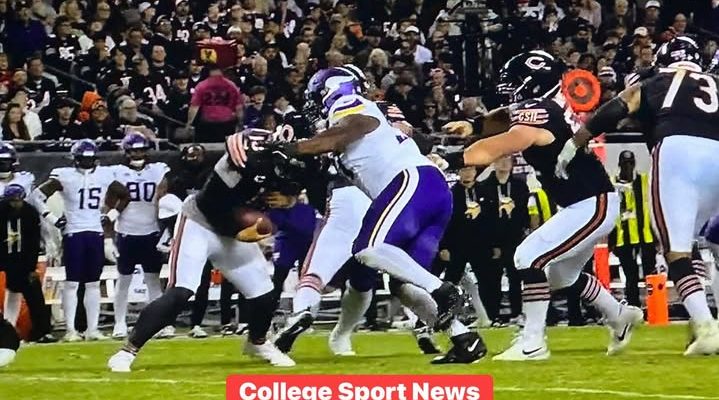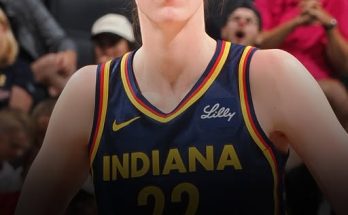The momentum in football can turn in the blink of an eye, and sometimes the sequence of just a few plays can completely shift the course of a game. That’s exactly what happened in the fourth quarter when the Chicago Bears, fresh off Jefferson’s touchdown, were given the ball with a chance to mount a response. Everything about that drive felt pivotal. The crowd knew it, the players knew it, and you could almost feel the pressure radiating from the sideline. What unfolded was nothing short of a masterclass in defensive execution by the Minnesota Vikings, proving once again that football is as much about seizing the moment as it is about the X’s and O’s.
The first punch was landed by Javon Hargrave, whose sack completely blew up what Chicago had envisioned for that opening series. A sack isn’t just about the yardage lost; it’s about what it does to the psychology of the offense. Suddenly, the play-calling gets tighter, the quarterback feels rushed even when he has time, and the offensive line begins to question whether they can keep their QB upright. Hargrave’s presence on that play was undeniable, and the energy it created rippled not only across the defense but also through the entire stadium. The roar from the Vikings’ faithful after that sack was like a war cry, and it set the tone for what was about to come next.
Eric Wilson then delivered a clinic in gap recognition with a timely tackle for loss. Plays like that don’t just happen by accident; they require anticipation, discipline, and the ability to diagnose what the offense is trying to do before the ball is even snapped. Wilson knifed into the backfield with the kind of decisiveness that makes running backs hesitate just a split second too long. That hesitation was all he needed to make a big stop. The Bears, already backed up from the sack, suddenly found themselves in an even deeper hole. Third down was looming, and you could almost feel the pressure building on the Chicago sideline.
But it was Andrew Van Ginkel who nearly put the exclamation point on that series with what could have been a pick-six. His pass breakup was not just a deflection; it was a play that had fans holding their breath because for a split second it looked like the Vikings were about to slam the door completely. The instincts he showed in reading the quarterback’s eyes, breaking on the ball, and getting there just in time to disrupt the pass demonstrate exactly why defenses need playmakers at every level. Even though it didn’t result in a turnover, the psychological effect of that near-interception was immense. It was a loud reminder to Chicago that nothing was going to come easy against this Vikings defense.
When you step back and look at that three-play sequence—Hargrave’s sack, Wilson’s TFL, and Van Ginkel’s breakup—you see the anatomy of what a game-changing series looks like. Each play stacked on top of the other, suffocating Chicago’s attempt to answer Jefferson’s touchdown. It wasn’t just about stopping the Bears in that moment; it was about swinging the momentum fully to Minnesota’s side. Every fan who’s been watching football long enough knows that these are the sequences that define games. They might not show up on highlight reels the same way a long touchdown pass does, but in terms of impact, they are every bit as significant.
What makes this even more impressive is how the Vikings’ defense had been playing all night. From the first whistle, they had shown that they were prepared, disciplined, and unrelenting. Chicago never seemed comfortable, and every time they tried to find a rhythm, the Vikings found a way to disrupt it. Whether it was pressure on the quarterback, solid tackling in the open field, or tight coverage downfield, this was a defense operating in sync. You could see the trust between the front seven and the secondary, each group feeding off the other’s energy. When the defensive line generated pressure, the defensive backs capitalized. When the coverage was tight, it gave the front seven extra seconds to get home. That kind of cohesion doesn’t happen overnight; it’s built on preparation, trust, and a collective hunger to dominate.
The Vikings’ defensive performance in this game is a reminder of something fans sometimes forget in an era where offensive highlights often dominate the headlines: defense still wins games. For all of Jefferson’s brilliance on offense, it was the defense that ensured that his touchdown meant something. Without that stop, without that suffocating series right after his score, the Bears could have regained control, or at least neutralized the Vikings’ momentum. Instead, Minnesota doubled down and asserted that this was their night.
What’s especially fascinating is how individual effort and collective energy came together in that series. Hargrave made the sack, but that sack happened because of consistent pressure that had been applied throughout the game. Wilson’s tackle for loss was a product of film study, anticipation, and team defense that funneled the play his way. Van Ginkel’s breakup came from tight coverage schemes that gave him the chance to jump the route. Each player shined in their moment, but it was the collective performance of the defense that allowed them to succeed.
For fans watching at home or in the stands, that kind of sequence is electric. It’s the kind of stretch that leaves you shouting at the TV, jumping up from your seat, or high-fiving the stranger next to you in the stadium. It’s a reminder of why we love football: the drama, the tension, the release of energy when a big play is made, and the knowledge that sometimes three plays can carry as much weight as an entire quarter. The Vikings gave their fans a show, and it’s one they won’t soon forget.
It also leaves a lot to discuss. How do you rank those three plays in terms of impact? Was Hargrave’s sack the biggest moment because it set the tone? Or was it Wilson’s tackle for loss, which buried the Bears deeper? Maybe it was Van Ginkel’s near-pick-six that truly slammed the door. Fans will debate these kinds of questions endlessly, and that’s part of the beauty of the sport. There isn’t always one right answer; it’s about perspective, passion, and the details you value most in the game.
There’s also the bigger picture to think about. What does this performance say about the Vikings’ defense moving forward? Can they replicate this level of intensity week after week? If they can, they suddenly become not just a team with offensive star power but a legitimate contender capable of grinding out wins in tough situations. Great teams aren’t just about scoring points; they’re about preventing them. And this game was a statement that the Vikings have the tools, the mindset, and the players to do just that.
For Chicago, this series was a nightmare. To come out after Jefferson’s touchdown and immediately get stifled in such a decisive way has to be demoralizing. Momentum is everything, and they had no chance to regain it. Their offensive line looked overwhelmed, their play-calling became predictable, and their quarterback never had the chance to settle into a rhythm. It’s one thing to get stopped; it’s another to get dismantled the way they did on that series. You can bet they’ll be watching the tape over and over again, trying to figure out how it all unraveled so quickly.
In the end, though, the focus has to remain on the Vikings’ defense. They weren’t just good—they were dominant. They showed what happens when preparation meets execution, when individual effort combines with team chemistry, and when hunger for a win drives every snap. This was a defense that refused to break, a defense that made its presence felt in the most critical moment of the game, and a defense that deserves all the credit it’s getting.
So let’s talk about it. What did you think was the most impressive part of that series? Was it Hargrave’s raw power on the sack, Wilson’s anticipation on the tackle for loss, or Van Ginkel’s instincts on the pass breakup? How high do you rank this defensive performance compared to others we’ve seen from the Vikings in recent years? Do you think this defense has the consistency to carry the team deep into the season? And perhaps most importantly, what does this kind of defensive dominance tell us about the identity of this team moving forward?
Drop your thoughts in the comments because this is one of those performances that deserves to be broken down from every angle. Everyone’s going to see something different, whether it’s the technique on a play, the energy from the crowd, or the way the momentum shifted. That’s the beauty of football—we all experience it differently, but we share the same passion for the game. Let’s give the Vikings’ defense their flowers and start the conversation about just how far they can go if they keep delivering nights like this.



